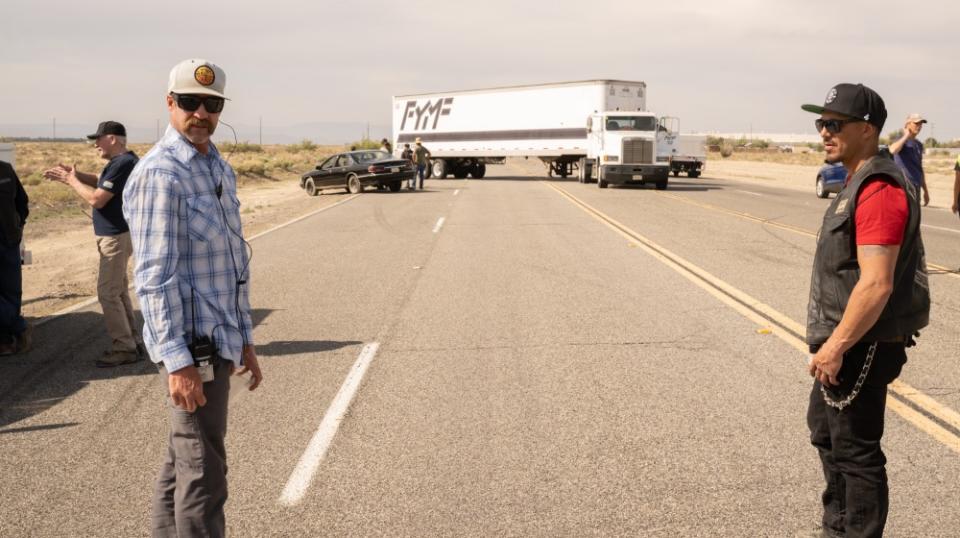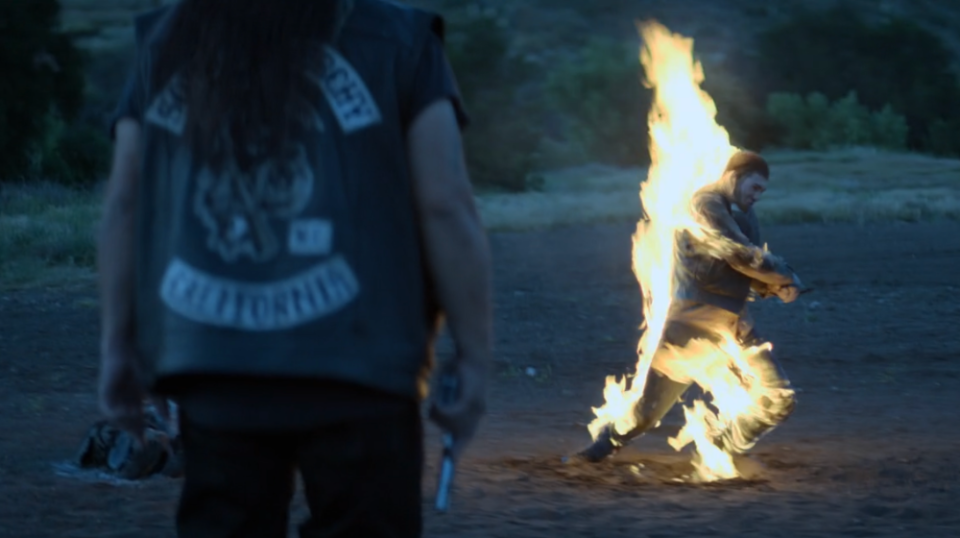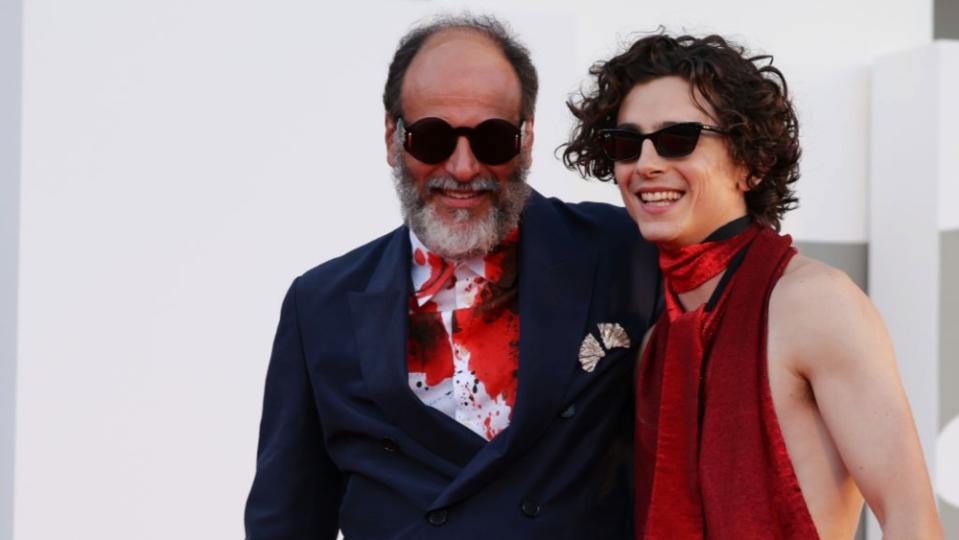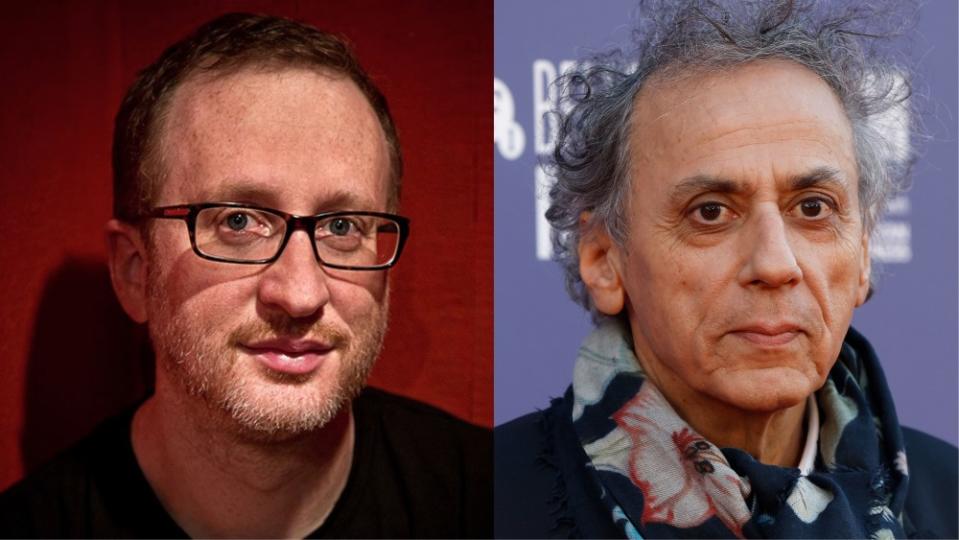Character Counts in the Stunts of Chad Guerrero and Oakley Lehman

- Oops!Something went wrong.Please try again later.
The latest season of “Mayans M.C.” opens with 47 minutes of essentially non-stop action, as members of the title motorcycle club find their clubhouse under siege. In an episode that could accurately be called “Saving Private Mayan,” tensions begin at a boiling point and only get worse as the bikers of the Santo Padre charter are surrounded by rivals and forced to defend themselves against an unceasing barrage of bullets and Molotov cocktails. The violence is constant, brutal, and immersive in a way that rewards repeat viewings; revisiting the episode, it’s surprising how short some of the bursts of intensity are — like the shower scene in “Psycho,” they play longer and more graphic in our memory because the emotional immediacy and filmmaking craft are so exact.
Showrunner and director Elgin James wrote the episode with confidence that he would be able to stage the action in the visceral, realistic manner the material required, because he knew who would be helping him realize his ambitions: stunt coordinators Chad Guerrero and Oakley Lehman. “A lot of TV scripts just say that a brawl happens, with no specificity,” James said. “I can write very, very specifically, but only because I know I have Chad and Oakley to make it happen. It always starts on the page, but they get their hands on it and build it into something else.”
More from IndieWire
Guerrero and Lehman’s history with “Mayans M.C.” began with the pilot, where Guerrero worked as leading man JD Pardo’s double and Lehman was a stunt driver. In season three they were hired as stunt coordinators, responsible for helping to conceive and execute the show’s electrifying motorcycle chases, shoot-outs, and fight scenes, all while making sure the cast and crew were safe. The increased realism and impact of the action was immediately evident to the show’s fans (the early season three episodes directed by Michael Dinner remain kinetic high points of the series), as well as to its creator. “I had this theory that the violence should be emotionally based and subjective,” James said, “and I could verbally articulate it but I didn’t know how to physically articulate it. That’s where Chad and Oakley are incredible — I can clumsily say something and they put it into action.”

For both Guerrero and Lehman, working as stunt men and stunt coordinators is the fulfillment of a childhood dream. Guerrero first became hooked on stunts when his father took him to a theme-park Western show. “It always stuck with me, and as I got older I learned about live stunt shows and got myself into those,” he said. Guerrero eventually moved to Los Angeles and made his way into the live stunt show circuit there, which led to opportunities in film and television; before “Mayans,” he racked up an impressive resume that included stunt work on the “Transformers,” “Thor,” and “Expendables” franchises as well as television shows like “NCIS,” “Westworld,” and “Barry.”
A young Oakley Lehman had a unique window into the world of television stunts. “I grew up in Sunland-Tujunga, where they shot ‘Dukes of Hazzard’ and ‘The Fall Guy,’” he said. “We could ride our bicycles over and watch them shoot, then we would see it on TV.” In a foreshadowing of his work on “Mayans,” Lehman’s passion growing up was motorcycles, and he began racing them professionally at 17. At 23 the opportunity to do stunt work arose and Lehman retired from racing to work on six “Fast and Furious” movies, initially doubling for Paul Walker and ultimately serving as coordinator on “Furious 7.” He also became a trusted collaborator of directors Robert Rodriguez and Quentin Tarantino and a go-to stunt performer for Marvel on movies such as “Iron Man,” “Black Panther,” and “Ant-Man and the Wasp.”
For all of Lehman’s work on big-budget franchise movies, however, he feels that “Mayans M.C.” is the closest to his own personal taste and sensibility. “As much as we love big action as stunt coordinators, those ‘Fast and the Furious’ movies don’t really do it for me,” he said. “Elgin is all about story and drama, and it’s really fun for us to come up with action that he likes, that isn’t too ‘stunty.’” Guerrero added, “Some of the big action movies have really cool, amazing scenes, but there can be greater shock value from something that’s more realistic. We’re always trying to build that into our stunts, to make them raw and gritty.” According to Lehman, there’s a shared sensibility between him, Guerrero, and James that makes production “smooth and easy. We’re all around the same age and have similar ways of thinking. We’re very fortunate in that Elgin comes from a real background — he’s not just trying to recreate gangster stuff he saw on TV.”
That background, which includes a youth spent in foster care, gangs, and ultimately prison, has strongly shaped James’ philosophy about presenting violence on screen. Like John Ford, Sam Fuller, and other directors of the Hollywood studio system who witnessed the savagery of war firsthand, James’ approach is largely informed by his personal experiences. “Coming from a world of violence, I want to show what it’s like to be both the victim and the aggressor,” he said. That guiding principle has led to an aesthetic that often creates logistical challenges for Guerrero and Lehman. “The way we shoot makes their job a lot harder,” said James, “because it’s so specific. We don’t always shoot with a lot of cameras. Sometimes we’re locked off in the back of a truck and someone gets hit by a car or a van and goes flying, and there are no other angles of it. You see it or you don’t, and the amount of work that goes into making it not only safe but thrilling and emotional is why Chad and Oakley are geniuses.”
The challenges are increased by the fact that the ambitions of the filmmakers on “Mayans” often outstrip the show’s resources. As James put it, “We’re trying to make a huge film on a basic cable budget.” Working in close collaboration with James and cinematographer Vanessa Joy Smith, Guerrero and Lehman have figured out how to turn those limitations into assets, shooting action in a way that both hides the budgetary restrictions and emphasizes the subjectivity toward which “Mayans” strives. Shots tend to be tighter and more precise than on other action shows, focusing on moments and gestures that convey pain and terror with immense visual economy and power. “That’s where Chad and Oakley have to be spot on,” James said. “There’s no room for anything other than that very specific bit of frame where the action happens.”
While Guerrero and Lehman’s technical skill is clear, their secret weapon is a character-driven approach to stunts, something “Mayans” lead JD Pardo has appreciated since his first encounter with Guerrero 10 years ago, on the series “Revolution.” “What’s special about Chad and Oakley is that they are artists,” Pardo said. “They have everything that’s required to be a stunt man — they can do their flips, they can fight, they ride motorcycles — but what separates them is their passion for the art and their relationship to the actor. They care so much that it feels like we’re creating the character together.”
Pardo and Guerrero’s partnership is one of the great ongoing actor-stuntman relationships in Hollywood, and to hear Pardo tell it the collaboration was magic from the start. “I was on ‘Revolution,’ and the stunt coordinator introduced me to Chad and said, ‘This guy’s going to double you,’” Pardo remembered. “I watched him do the scene and I went over to him and said, ‘Hey, you’re doing great, but if you could do me a favor — this is what I would do as the character. If you could just add this little wrinkle into the movement it would be really cool.’” Guerrero immediately made the adjustment exactly as Pardo had hoped, and from that point forward Pardo brought the stuntman onto his projects whenever possible. “I told him, one day I’m going to be the lead on a show and I’m going to bring you with me. And he didn’t laugh at me — he said, ‘Okay, let’s do it.’”
When Guerrero was promoted to coordinator at the beginning of season three he had Pardo’s blessing — especially since he did double duty, continuing to double for the actor. “Chad’s mine,” Pardo laughed. “No one’s taking him away from me!” Guerrero attributes the success of their partnership to mutual trust: sometimes Guerrero lets the athletic Pardo handle the physical demands of a scene, but Pardo can also rely on Guerrero to perform as his character in less stunt-intensive scenes if necessary. “We know when it’s my time to get in the hot seat and when he’s okay doing it,” said Guerrero. “Over the years we’ve become really good at knowing each other and knowing when to swap out.” Pardo mentioned that at times when he is not able to be on set and Guerrero is doubling him on a motorcycle, “I’ll always get a call saying, ‘Chad wants to know if [the character] would do this or that.’ And I tell them and he does it.”

Guerrero and Lehman look for a similar level of dedication in all the stunt people they hire. “We’re only as good as who we bring in, so we make sure they’re top-notch,” Guerrero said. He didn’t have to look far for a stuntman who has become one of the show’s most reliable utility players: Guerrero’s son, Chad Guerrero Jr. “There’s nobody better,” Lehman said, noting that when it was time for a particularly tricky fire stunt in the Season 4 finale, the younger Guerrero was his first choice. “For Oakley to request Junior and trust him with that was a pretty big deal for me,” Guerrero said, adding that he and his son had been practicing for the scene for years. “I first set him on fire when he was 9 years old,” Guerrero laughed, “so he was ready!”
Guerrero’s pride in his son’s work is as close as he or Lehman gets to acknowledging the difficulty or impressiveness of what they do; the more time one spends with them, the clearer it becomes that they’re incredibly modest given their talent and contribution to “Mayans.” “They don’t ask for applause or acclaim,” “Mayans” cast member Clayton Cardenas said. “They’re not like us actors on social media saying, ‘Look at me!’” Guerrero added that he hesitates to talk too much about what he does because he likes the audience to retain a sense of mystery about it. “I like being behind the scenes and not in the spotlight. That’s why I’m a stunt man and not an actor.”
Lehman is similarly unpretentious, with a humility that drives him to continue working on his craft. “A lot of kids ask me what they need to do to get work, and they get irritated when I tell them to talk less and train more,” he said. “Everybody wants to post that one time that they were great, but you’ve got to train every day. Chad and I are in our 40s and we still train every day.” Their dedication is not only evident in every body fall, motorcycle crash, and explosion on “Mayans” — it’s a quality that inspires everyone around them on set. “They make us look good and do a job that I could never do,” Cardenas said. “I have so much respect for them. They’re heroes, man.” —Jim Hemphill
VIEW MORE INFLUENCERS PROFILES

Luca Guadagnino & Timothée Chalamet
With “Bones and All,” the director and star of “Call Me by Your Name” continue to give each other the space to be bolder, darker, and more vulnerable.
December 1, 2022 12:08 pm

Nicholas Britell & Cellist Caitlin Sullivan
“She Said” and “Succession” composer Britell says he knows he’s on the right track when Sullivan pokes her head into the couple’s home studio.
By Erik Adams
November 18, 2022 2:17 pm

James Gray & Cinematographer Darius Khondji
What’s the collaborative process behind “The Immigrant,” “Armageddon Time,” and “The Lost City of Z”? “No conversation. Just sharing paintings.”
November 10, 2022 11:00 am
Best of IndieWire
The Best Thrillers Streaming on Netflix in October, from 'Fair Play' to 'Emily the Criminal'
Christopher Nolan's Best Shots: 40 Images That Define the Director's Career
Sign up for Indiewire's Newsletter. For the latest news, follow us on Facebook, Twitter, and Instagram.

